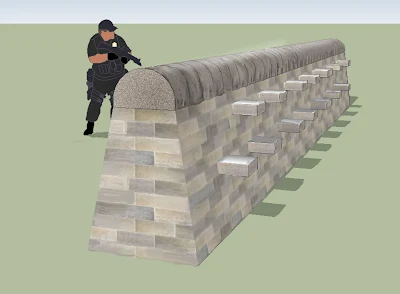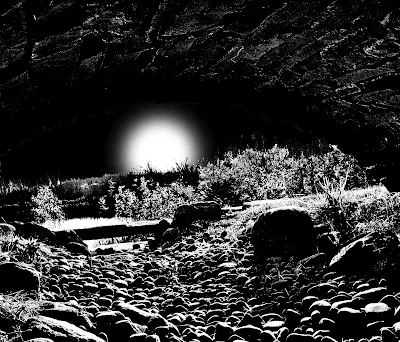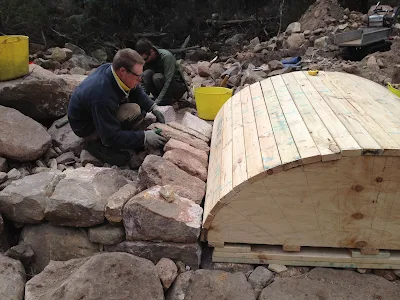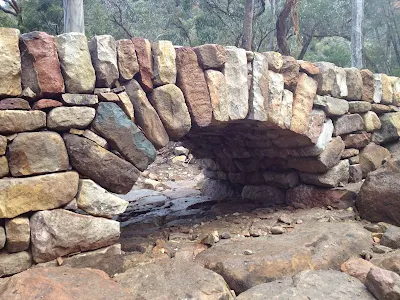Friday, November 30, 2012
Thursday, November 29, 2012
Arched Water Feature
I was honoured to be able to work this week with Jason Hoffman helping him on a unique dry stone retaining wall project which included the building of a recessed arch opening over a stone water trough where natural spring water flows through a stone spout and into an old stone trough. (The trough which was hewn hand wash basin, came from a old mill in Lancashire )
The actual moment that the forms come out (presuming the arch doesn't fall down) is always a great time of rejoicing.
Wednesday, November 28, 2012
Tuesday, November 27, 2012
Poetry in the Glen

In part one Norman talks about this historic dry stone structure above, Glen Lyon Bridge. Glen Lyon itself is a magical area in Scotland (as you will hear about in the documentary) a place which I was privileged to have Norman show me and together we rebuilt dry stone walls on my last two visits there. I am off to visit him again in December.
part 1: http://www.youtube.com/watch?v=JgpUmCTobr0&list=UUdojpTnbpQ1vXlSgTHBMojg&index=7&feature=plcp
part 2: http://www.youtube.com/watch?v=qNvRoQWNq5U&list=UUdojpTnbpQ1vXlSgTHBMojg&index=6&feature=plcp
Monday, November 26, 2012
Improvisations in Stone
This book covers the period 2009— 2012 and includes seminars, festivals, public installations, stone balancing and private work.
The price of $70 per copy (without shipping) is being charged for this privately printed coffee table book, and represents the actual cost of the book.
If you would like more information, sample pages, or would like to order a copy of Improvisations in Stone 2009-2012
please e-mail mcclaryharris@sympatico.ca
Sunday, November 25, 2012
Job Opportunities.
I recently got a notice via the DSWA of Australia concerning job opportunities for masons (don't know if it involves dry stone work or not) which have now become available in New Zealand. You might like to pass this on to someone you know (and like) who would be interested and is a competent mason.
----------------------------
"I am a stonemason based here in New Zealand . Currently we employ 12 masons over our Wanaka and Christchurch branches . Our website is www.southernstonemasons.co.nz . We are looking at recruiting some more guys . What i offer is to sponsor candidates visa application . And a chance to have regular work and a good income in this beautiful country .
Robin Dalton
Southern Stone Masons ltd
68 Macdougall st
Wanaka
Tel 0272721007."
----------------------------
We have also posted this request on our 'Help/Work Wanted' page of Dry Stone Walling Across Canada
Saturday, November 24, 2012
Wall the rage.
Dry stone walls: their cleverness lies in their simplicity. Photograph: Liz Eddison/ garden-collection.com
I'm off to Scotland today for three weeks to help Jason Hoffman build some new dry stone garden walls. Ill be blogging from there.
There are lots of old walls there - livestock enclosures mostly, lots of them need fixing too.
But new garden walls are fairly rare.
Apparently Britain has only recently discovered that these dry stone walls are cool and always remain in style. Check out yesterday's Guardian.
http://www.guardian.co.uk/lifeandstyle/2012/nov/23/gardens-dry-stone-walls
Friday, November 23, 2012
Rolling around ideas about rolling stones and moss
Rolling stones mostly just gather speed.
I guess they just aren't sticky enough.
I wonder if there is such a thing as double-sided moss?
I should try the experiment again perhaps, because I'm not sure the moss was ready.
On the other hand,
It has been suggested that painting yogurt on the stones helps them gather moss.
In that case my next rolling experiment will have to be a bit messier.
In that case my next rolling experiment will have to be a bit messier.
Thursday, November 22, 2012
A Bridge Sign
This is the design for the Kay’s Bridge interpretive sign . It tells the story of the bridge we built in 2010 at Landon Bay Park near Gananoque on 1000 Islands Parkway.
It is 3’x 4’ and will be installed next spring.
Charlie Donevan and his wife Kay had so much to do with developing this property and particularly securing this park for public use with foot paths and camping and signed nature trail.
A dedication ceremony will be held when the sign is installed
The designer is Brian R. Phillips
Wednesday, November 21, 2012
Tuesday, November 20, 2012
Monday, November 19, 2012
What is level?
My clients told me that one day they watched as two men with a four foot spirit level got out of a truck (having driven by several times before) and walked up to the dry stone wall we built four years ago and measured it to see if the coursing was running exactly horizontal. It must have been some sort of bet or dispute they were having and they had to prove who was right.
The wall was built on a hill that rose about three inches every foot. The courses do look level, but their not. They were built leaning slightly downhill. To build the wall exactly level would have made it look too severe. Sometimes you have to go with your eye and what looks right. No big deal, but then again the guys measuring the wall thought it was.
Sunday, November 18, 2012
Walking again.
Im excited to announce that in 2013 we will be running our third annual Walk the Walls Tour. This time it will take us to Wales and Northern Scotland. Again we will visit the historic and contemporary sites of stone walls, quarries, bridges, buildings and follies and discover some of the varied manifestations of 'walls without mortar' as well as learn about the history of dry stone walling in two very interesting areas of Britain. We are hoping that people will absorb themselves in the landscape, the music, the food and the traditions of the regions we visit. In each locale we will meet some familiar friends from previous D.S.Walling Across workshops and annual festival held in Canada
Our Wales component of the trip will take us to the Llandberis area, to Snowdonia National Park, to the foot of Mount Snowdon, the highest peak in England and our welsh hosts Sean and Brenda Adcock. Sean is the Honorary Secretary of the North Wales Branch of the Dry Stone Walling Association and well known to many of our North American walling friends.
North Wales is home to a series of World Heritage Site castles constructed in the 13th Century; the most noted is Caernarfon Castle, built by Edward 1 and the site of the Prince of Wales investiture in 1969. We will also visit the famous slate quarries and the National Slate Museum...slate being the gruelling backbone of the North Welsh economy. Of course there will be lots of walking, the only real way to see the landscape and a chance to try a hand at walling, possibly with the DSWA, North Wales Branch project at Pen y Pass.
The second half of our trip will be to northern Scotland to the Sunderland, Llairg, Rosehall, to visit our hosts Dave and Mary Goulder. Dave totes his Master Craftsman's walling certificate around with him as well as his guitar and members of his Rosehill Ceilidh band. Dave will take us on a journey to his remote and beautiful part of the country, to a land of 'legendary stones'.
If you are interested in coming along please write to Margot Miller margotm@1000island.net for more details about this trip
Saturday, November 17, 2012
No Idling
This heavy John Deere was the first tractor to go over the then recently completed double arched bridge that a crew of international dry stone wallers built during the very successful 2012 'Festival of Stone' near Montreal back in October. We asked Jason to turn off the tractor and relax, enjoy his beer and wait see if any thing happened. We all watched and listened. There was a kind of clicking noise. It was the sound of cameras.
Friday, November 16, 2012
A civil wall battle and the death of Stonewall Jackson
The Second Battle of Marye's Heights (Fredericksburg) took place here on May 3, 1863.
The Battle of Chancellorsville was a major battle of the American Civil War, and the principal engagement of the Chancellorsville Campaign. It was fought from April 30 to May 6, 1863, in Spotsylvania County, Virginia, near the village of Chancellorsville.
Two related battles were fought nearby on May 3 in the vicinity of Fredericksburg. The campaign pitted Union Army Maj. Gen. Joseph Hooker's Army of the Potomac against an army less than half its size,Gen. Robert E. Lee's Confederate Army of Northern Virginia.
Chancellorsville is known as Lee's "perfect battle" because his risky decision to divide his army in the presence of a much larger enemy force resulted in a significant Confederate victory. The victory, a product of Lee's audacity and Hooker's timid decision making, was tempered by heavy casualties and the mortal wounding of Lt. Gen. Thomas J. "Stonewall" Jackson to friendly fire, a loss that Lee likened to "losing my right arm."
That same day Maj. Gen. Jubal A. Early was defending Marye's Heights in Fredericksburg, Virginia, with the Confederate army's reserve artillery and a small infantry force of about 10,000 men from his own division and Barkdale's Brigade. Much of his force was spread out thinly to the north and south of the Heights. Maj. Gen. John Sedgwick, reinforced by the II Corps division of Brig. Gen. John Gibbon, moved their soldiers through Fredericksburg and towards the plain below the Heights, then stopped and engaged in long range artillery fire with the Confederates for most of the morning. At about noon, after failing twice in previous attacks, Sedgwick sent ten Federal regiments against Early's defenses, the 5th Wisconsin in front as skirmishers.
The 5th went forward with a cheer, the other regiments close behind, and they were met with concentrated fire from the Confederates waiting behind a four foot dry stone wall. The charge stalled there for a time, then portions of the Union right found their way through nearby gardens and fences and climbed over a portion of the stone wall, then poured enfilading fire into the thin Confederate line on the left flank. The Federals charged in, bayoneted the closest defenders, and captured several enemy guns. The greatly outnumbered Confederates withdrew and regrouped to the west and southeast of Fredericksburg, and though it took three charges, Sedgwick's men finally captured Marye's Heights.
The 5th went forward with a cheer, the other regiments close behind, and they were met with concentrated fire from the Confederates waiting behind a four foot dry stone wall. The charge stalled there for a time, then portions of the Union right found their way through nearby gardens and fences and climbed over a portion of the stone wall, then poured enfilading fire into the thin Confederate line on the left flank. The Federals charged in, bayoneted the closest defenders, and captured several enemy guns. The greatly outnumbered Confederates withdrew and regrouped to the west and southeast of Fredericksburg, and though it took three charges, Sedgwick's men finally captured Marye's Heights.
About 2000 soldiers died at the second battle of Fredericksburg.
The Civil War lasted from 1861 to 1865.
Much of this information was gathered on Wikipedia.
Thursday, November 15, 2012
Protruding Agenda
Continuing on yesterday's theme, I have to ask why certain dry stone wallers in the U.S. and Canada (the ones who are confident using gas-saws, grinders, points and chisels as well as hammers) still need to position their smartly trimmed squarish throughstones so that they hang out over both sides of their walls? If they can fit every other stone flush along rows of straight coursing in their tidy dry stone creations, why not line the throughstones up along the plane of the wall too? Does the fact that we need to see all these protruding throughstones signify something else perhaps?
Wednesday, November 14, 2012
Throughstones
A dry stone wall I'm working on this week.
While it's a good idea to put throughstones at regular intervals along a dry stone wall to make it more structural (if you have enough long stones in your random selection of stone to do so) I usually prefer not to have these high-profile thigh-smackers sticking out either side, even though my walls are generally random rubble style. Granted you can't often differentiate them from the rest of the builder stones in the wall, but that's not the point.
Usually the reason they stuck out on traditional British walls was either because the lord of the property wanted to see them just to make sure the hired wallers were not skimping on them, or more often because the random stones that were long enough to serve as through stones were often awkward to shape, and common wallers building miles and miles of enclosure walls wouldn't have wanted to risk accidentally breaking them shorter than desired, just because they wanted to try to make them fit the exact width of the wall.
Tuesday, November 13, 2012
Squiggly Lines
Is it me or are landscape plan views pretty much squiggly lines that are not very helpful if you want to know anything about the dry stone wall you've been hired to build?
They only tell you where it is going. They never take into account that a wall has batter or how it will line up with a corner of a building or how it will turn into a pillar at the driveway. They never show how anything will look or how it will actually be built. I suspect that's because most landscape architects don't really know.
Why can't they give you drawings more like this one I just got from a landscape architect for a job we just started last week. This perspective site drawing gives so much more information. It's a treat to try to reproduce the vision of this architect, and the client knows what they are getting too.
Monday, November 12, 2012
The Vault of Heaven
First pebble - "Look at all those those vousstars"
Second pebble - "Yeah, they're beautiful tonight"
Big rock - "You can see all the astral configurations"
Another rock - " It's amazing the way they line up isn't it?"
Large stone - "Yup . They're all in a kind of elliptical alignment I think."
Second pebble - "Yeah, they're beautiful tonight"
Big rock - "You can see all the astral configurations"
Another rock - " It's amazing the way they line up isn't it?"
Large stone - "Yup . They're all in a kind of elliptical alignment I think."
"It's getting brighter now"
"I wish I could appear in the night sky like that. Just hanging there in the air . Nothing visible holding you up. Shining brightly like diamonds."
"You can see the actual 'vault' in the sky now"
" It really is an amazing display! "
"It's so wonderful to know that it's possible for mere stones like us to rise up one day like that too."
"Sigh"
Saturday, November 10, 2012
Venus Bath Bridge - Part 3
With the former in place between the two arch footings, work could commence on constructing the six foot span arch barrel. The first step was to collect sandstone from the surrounding area with a mechanised wheel barrow and shape it into voussoirs with tools such as a bull set, slab splitter and hammer point. Once enough voussoirs had been found, we began laying them on the former. With the barrel complete we then built the spandrels and approaches. This was followed by the fitting of large coping stones which served to contain the pitching stones layed in between. The pitching formed a durable tread as well as strengthening the rest of the bridge. The structure was built to stand up to future floods and in theory should be able to cope with being completely inundated.
The bridge took a month to build and used about forty tons of stone. This was the first bridge project I supervised without the help of other experienced wallers and also, to my knowledge, the first drystone bridge to be built in a Victorian national park. I would like to take this opportunity to thank those that have taught me the art of bridge building over the years and in particular John Shaw-Rimmington and Patrick McAfee, as this project would not have been possible without their willingness to share their skills and knowledge.
Friday, November 9, 2012
Venus Bath Bridge - Part 2
Gavin continues his story of building the Venus Baths Bridge in Australia.
The park managers' stipulation was that the bridge be large enough to cope with the stream's (at times) heavy flow while being low enough that it wouldn't need a hand rail due to fall height considerations. I thought a good solution would be to employ an elliptical arch as this would allow adequate water flow whilst being lower than a semi-circle or segmental arch of equivalent opening dimensions.
I am indepted to Pat McAfee for providing advise and cautioning me as to the particular tolerances associated with elliptical arches due to their low span/height ratios. Mortar is typically used in these arches to harden them and ensure good bed contact between the voussoirs. To help address these concerns in my drystone structure, I took particular care in shaping the voussoirs to achieve a snug fit as well as making the barrel thick to avoid the risk of having the line of thrust go outside its surface boundary and a 'hinge' developing - the extrados(outer curve of the arch) actually formed part of the tread, or walking surface, and is something I had come across on pack-horse bridges in the Lake District in the UK. Laying stone pitching for the remaining sections of tread would further increase the bridge's overall strength and thus tolerance to vibration and other forces.
Here is a very easy method for drawing an elliptical arch.
http://www.thisiscarpentry.com/wp-content/uploads/2012/02/Ellipsestring-method.pdf
Grant Rose assembles the four elliptical ribs of the ply wood former.
Gavin assembles the bottom cross pieces .
Thursday, November 8, 2012
Venus Bath Bridge - Part 1
Venus Baths
Gavin Rose who flew to Canada to attend our DSWAC 'Festival of Stone' last month to build the double arched dry stone bridge near Montreal had just completed a bridge of his own back in Australia. Gavin remained in Ontario to help me on a few other dry stone projects. I was fascinated to hear the story of his bridge and to see photos of the various stages of construction. I asked him to write a short piece about the process which will be posted here in three parts.
-------------
The Grampians National Park in the southern state of Victoria in Australia experienced catastrophic flooding in January of 2011.
Many trails including the park's very popular Venus Baths walk had to be closed as they had been rendered unsafe due to the extensive damage.
The power of the flood was so great that it diverted around one of the path's bridges and created a new channel. The Park's managers deemed it prudent to let nature take its course and allow the stream to remain on its new alignment. I was asked to install a concrete culvert over the new channel in order to reopen the trail but fortunately, after some persuasion, the managers were talked into the idea of constructing an aesthetically more pleasing drystone arched bridge.
The first task was to divert the stream with an excavator so that construction of the foundations could commence. Once this was done very large stones were placed in the deep trench dug by the excavator followed by the footings for the arch and pitching stones between the two footings.
Wednesday, November 7, 2012
Spinning Gold
Working with an awkward shaped random granite found near the shoreline of a lake in the Haliburton Hills Ontario area this week. I feel like I'm expected to spin gold from straw. The project requires I make 60 feet of perfectly flat 22 inch high wall. As soon as you lay the first random hexagonal shaped stones in a course you have to worry about how the next stone course will bring it to level. And all these cap stones need to be big stones too . We are doing the impossible here.
Here is our selection.
Its a curved wall that surrounds a new amphitheatre.
Pretty nice eh?
Tuesday, November 6, 2012
Subscribe to:
Comments (Atom)















































